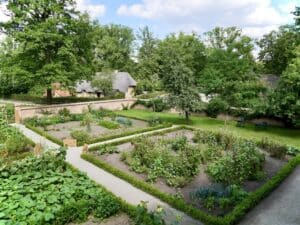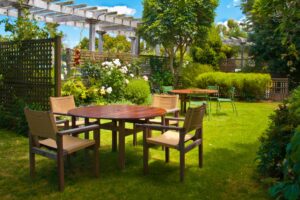A Guide to Bare Root Trees

June and July means that it’s bare root tree Season here in Australia, and it’s one of our favourite times of the year at Diacos. But what exactly is a bare rooted tree? If you’ve only just heard the term, or you’re just looking to do a little more research before buying or planting, then look no further. Our gardening experts have put together this comprehensive guide to bare root trees.
We’ll talk about what a bare root tree is, how to plant and care for it, and some of the most popular bare root trees available. If you’re in a hurry – or you only want to know about planting information – you can check out our shorter quick guide, Grow and Care for Bare Root Trees.
What is a Bare Root Tree?
Bare root trees are ready-grown trees that have been uprooted from the ground where they were grown. Their root system remains fully intact even though it has been removed from the soil. These ‘bare’ roots are where these trees get their name.
So why don’t the bare roots suffer? Well, bare rooting can only be done with deciduous trees & shrubs while they are dormant. In Australia, this is usually during the months of June, July and sometimes early August.
Dormancy for plants is like a form of hibernation – they are conserving energy and nutrients to better survive the harsh conditions of winter. Fortunately, this also means they can be removed from one soil and placed into another without going into shock and distress.
Most bare root trees are around 2-3 years old when removed, meaning that you won’t have to wait very long to start seeing results! In fact, there are a number of benefits to choosing a bare root tree over one that comes in a pot or container.
Why choose a Bare Rooted Tree?
The most immediate benefit to choosing a bare rooted tree is that it’s usually a lot cheaper than a tree that comes in a container. According to the ABC, by choosing a bare root tree instead of a potted tree, you can generally save up to 50%!
If you have a long list of trees you’d love to buy, waiting until Winter for bare root tree season is not a bad idea. The best thing is that these trees aren’t just cheaper, they tend to grow better as well. This is because they have a much better chance of adapting to their new soil and location.
While the tree’s root system is dormant, it will adapt to being planted in new soil without much fuss, whereas a potted plant may struggle or go into shock when removed from its pot. The fast adaption time of bare roots tends to lead to faster plant growth and healthier results.
Bare root trees also arrive much more established in their growth than container trees, to better ensure the root systems can withstand being uprooted and replanted. As mentioned earlier, most bare roots will be at least 2 or 3 years old, and with a sturdy amount of roots already grown. This can save you a lot of time waiting for your tree to grow!
How to Plant Bare Root Trees
Preparation is the secret to planting your bare root and enjoying those easy results. It’s always a good idea to have everything prepared for your bare root tree before you bring it home. This gives your tree the best chance of survival.
If you do need to store your tree before planting, then it’s essential to keep the roots moist. Otherwise, they could be damaged, or could even dry out and kill your new tree.
To safely store your bare root tree, place it in a bag with wet sawdust or bury it in a shallow, moist hole. This is okay for up to a week, but the longer you leave it, the higher the risk of damaging your roots. If you’re only storing your tree for a day or less, you can place it in a bucket of water instead.
Preparing to plant
You want the best possible soil ready to go for your bare-rooted tree. Do some research first to find out what kind of soil your tree likes, or ask one of our friendly experts if you’re purchasing from our store. To better prepare your soil, add some compost & manure and mix it together with soil and water.
Now it’s time to dig the hole! Generally, you’re going to want a hole that is deeper than it is wide. Depending on your soil, we recommend digging roughly twice as wide as the root ball of your tree. Another rule of thumb is to go 10-20cm larger than if you were choosing a pot.
If you have poorer soil, you may need to go as large as 1 metre wide with your hole! Finally, make a small mound in the centre of the hole. This is where you’re going to place the roots, so make sure that this mound will allow the base of your tree to sit level with the ground..
Planting your Bare Root Tree
The idea is to bury the tree to the same height that it was at before it was uprooted – you should be able to see a colour change at the base of the tree where it once came out of the soil. That marks where the base of your tree should be above ground.
Place the roots on top of your soil mound in the middle of the hole, so that the base is at the desired height. Then, spread the roots over the mound evenly. Gently begin to fill in your hole, wiggling the tree slightly as you go to ensure the roots make good contact with the soil.
Finally, water the tree generously to give it a good start. If the tree is in an exposed area, you may need to stake the tree to protect it from harsh winds.
How to Care for Bare Root Trees
After you’ve planted your bare root tree, it’s still going to need a little bit of care to settle in properly. Because your bare root has been planted while dormant, it’s going to look like a bare, barren stick for a month or so before it begins to bloom and grow again.
Here’s what to keep in mind when caring for your new bare root tree:
Water and Mulch
During this period, your bare root tree will need a bit of extra care. Water your bare root more often for the first couple of weeks to ensure that the soil is consistently moist. Every 2nd or 3rd day is generally a good rule of thumb, though some species of tree may differ.
It’s important not to overdo this constant watering, as your root system will drown if it is completely soaked for a long period. Check your soil frequently to make sure that the water is draining away. You want it to be moist, but not waterlogged. Persistent puddles or mud is a bad sign.
On the other hand, if you’re struggling to keep your soil moist or think that you won’t be home enough to water regularly, Mulching around your tree can be an excellent solution. Mulch helps soil retain moisture for longer, reducing the need to water as frequently.
It can take around 2-4 weeks for the roots of your tree to become active again. Once they do, it’s time to reduce your watering to around once a week. Heavier, less frequent waterings will encourage a deeper, healthier root system.
Pruning
Pruning is an essential step to the success of your bare-rooted tree. When a tree is removed from the field, it loses a significant portion of its root system.
If you don’t prune it back, the tree will have an unbalanced root-to-tree ratio, which will cause serious problems. Depending on the tree, you will need to prune significantly so that the tree can establish itself more quickly.
This step is one of the most important parts of planting a bare root tree – don’t skip it!
Popular Bare Root Trees
There are more bare root trees in the world than we could possibly count. The availability of some bare root trees can also change from year to year. Still, there are some classic choices that you’ll tend to find every year. Here are 6 of the most popular bare root trees out there:
1. Fruit Trees
Fruit Trees are far and away the most popular bare root trees we sell, as purchasing your fruit trees in bare root form considerably cuts down on the amount of time that you need to wait before you can start to eat their delicious fruits!
There’s a huge variety of fruit trees that will thrive as bare root trees, including pear trees, plum trees, apple trees, lemon trees, fig-trees, cherry trees and even almond trees. Chat to our friendly team about what we’ve got in stock this year.
2. Maple Trees
Maple trees, including the stunning Japanese Maple, are some of the most splendid bare root trees available. They come in all kinds of visually striking colours, including purple, red, deep green and orange.
Planting your bare root tree while dormant does mean that you’ll be looking at a naked stick at first, but have a little patience and you’ll be rewarded with one of the most beautiful trees in the world. This is a striking way to add colour to any garden.
Japanese Maple trees aren’t always cheap to purchase as a potted plant, so buying during bare root season can often save you a lot of money.
3. Ginkgo Trees (Maidenhair)
This graceful, slow-growing tree is the oldest surviving tree on earth. It’s had a long time to get comfortable, so the Ginkgo tends to be very easygoing in most soils and conditions. It’s a great choice if you’re intimidated by some of the fussier trees on the list.
The huge, fan-shaped leaves of the ginkgo are beautiful and vibrantly green, transforming into a wonderful golden hue in Autumn. Going bare-root means that you can start to enjoy this pleasant, shady foliage even faster.
If you like the idea of planting a tree that will keep growing up as you grow old, then you’ll be impressed by the Ginkgo tree. It only grows by around 30cm a year, but it can reach up to 50-80 feet in height and 30-40 feet in diameter!
4. Silver Birch Trees
With their striking white trunks and elegant green foliage, birch trees are a classic. These are very popular for suburban gardeners, and the gently drooping branches of the silver birch certainly make for a lovely garden tree.
If birch trees are on your list, don’t go for a potted version. Potted birches will always turn out much smaller than a bare-root or soil-grown birch. That’s because these trees have impressive root structures that spread outwards as they mature, which a pot severely limits.
Because of this, birch trees require a medium-to-large backyard and a bit of space from other plants. However, a few birch trees placed close together can look absolutely stunning.
5. Claret Ash (Fraxinus)
Finally, the Claret Ash is another fantastic choice for a Bare Root Tree. These trees are famous for their beautiful red-to-purple foliage in autumn, for which they are aptly named. Tall, shady and graceful, this tree is a classic.
These deciduous trees love the full sun and grow extremely fast. Claret Ashes can grow upwards of a metre a year! This makes them a great choice for suburban or country gardeners, although like the Silver Birch, their extensive root system may not be well-suited to a smaller area.
Although fully grown Claret Ashes are tough and drought tolerant, they can be fairly sensitive in the first few years of their lives. Planting these trees bare root style means that you can skip most of this awkward phase. It will also give them a better chance of adapting to your soil than if you transferred the tree from a pot.
This has been our guide to bare root trees. Now you can see why bare root season gets us so excited here at Diacos! Waiting for the bare root versions of your favourite tree can save you a lot of time and money, and you’ll often end up with a larger, healthier tree.
Come into one of our Diaco’s Garden Centres during June and July to explore our extensive range of bare root trees. If you’re reading this guide outside of bare root season, feel free to ask one of our helpful gardening experts online about what you can expect to find when it comes around.
-
 13, Jun, 2025
13, Jun, 2025How to Start a Garden Design Project: Step-by-Step Planning Guide for Beginners
At Diaco’s, we know that creating a beautiful garden starts... -
 27, May, 2025
27, May, 2025Smart Garden Layout Ideas: How to Maximise Your Outdoor Space
At Diaco’s, we believe every garden has potential. Whether you’ve... -
 9, May, 2025
9, May, 20257 Garden Design Principles to Transform Your Outdoor Space
At Diaco’s, we know that creating a garden isn’t just...


